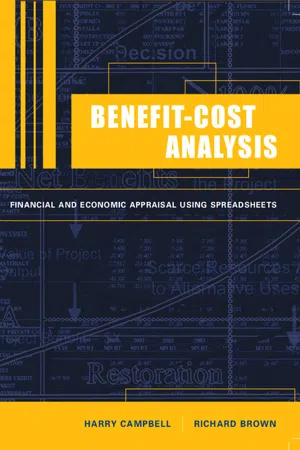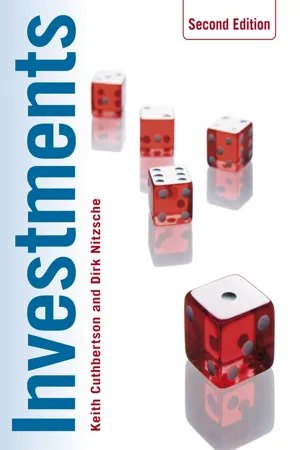Business
NPV Rule
The NPV (Net Present Value) rule is a financial concept used to evaluate the profitability of an investment. It compares the present value of expected cash inflows to the present value of cash outflows, taking into account the time value of money. If the NPV is positive, the investment is considered financially viable, while a negative NPV suggests the investment may not be worthwhile.
Written by Perlego with AI-assistance
Related key terms
1 of 5
12 Key excerpts on "NPV Rule"
- eBook - PDF
Benefit-Cost Analysis
Financial and Economic Appraisal using Spreadsheets
- Harry F. Campbell, Richard P. C. Brown(Authors)
- 2003(Publication Date)
- Cambridge University Press(Publisher)
Among these decision-rules the most well known are the net present value (NPV) criterion, the internal rate of return (IRR), and benefit/cost ratio (BCR). In the sections that follow we shall examine each of these criteria and their use-fulness in the different project decision-making situations. The Net Present Value (NPV) Criterion The NPV of a project simply expresses the difference between the discounted present value of future benefits and the discounted present value of future costs: NPV = PV (Benefits) – PV (Costs). A positive NPV value for a given project tells us that the project benefits are greater than its costs, and vice versa . When we compare the project’s total discounted costs and dis-counted benefits, we derive the NPV: Example 3.4: Comparison of Projects A and B using Net Present Value Project A: Year 0 1 2 3 (1) Cash Flow –100 +50 +40 +30 (2) Discount Factor (at 10%) 1.00 0.909 0.826 0.751 (3) Discounted cash flow (=1x2) –100.00 45.45 33.04 22.53 NPV(A) 0.1 = –$100(1.0) + $50(0.909) + $40(0.826) + $30(0.751) = $101.02 – 100.00 = $1.02 As NPV(A) > 0, accept the project (when cost of capital = 10%). Investment Appraisal: Decision-Rules 41 Project B: Year 0 1 2 3 (1) Cash Flow –100 +30 +45 +50 (2) Discount Factor (at 10%) 1.00 0.909 0.826 0.751 (3) Discounted cash flow (=1x2) –100.00 45.45 33.04 22.53 NPV(B) 0.1 = –$100(1.0) + $30(0.909) + $45(0.826) + $50(0.751) = –$100.00 + $27.27 + $37.17 + $37.55 = $101.99 – $100 = $1.99 As NPV(B) is positive, project B can also be accepted. Which project is preferred: A or B? As NPV(B) > NPV(A), B would be preferred to A (at 10% discount rate). The Effect of Changing the Discount Rate We have been assuming a 10% discount rate so far. - eBook - PDF
- Robert Parrino, David S. Kidwell, Thomas Bates, Stuart L. Gillan(Authors)
- 2021(Publication Date)
- Wiley(Publisher)
10.2 Net Present Value 10-13 Concluding Comments on NPV Some concluding comments about the NPV method are in order. First, as you may have noticed, the NPV computations are rather mechanical once we have estimated the cash flows and the cost of capital. The real difficulty is estimating or forecasting the future cash flows. Although this may seem to be a daunting task, managers with experience in producing and selling a particular type of product can usually generate fairly accurate estimates of sales vol- umes, prices, and production costs. Most business managers are routinely required to make decisions that involve expectations about future events. In fact, that is what business is really all about—dealing with uncertainty and making decisions that involve risk. Second, estimating project cash flows over a long forecast period requires skill and judgment. There is nothing wrong with using estimates to make business decisions as long as they are based on informed judgments and not guesses. Problems can arise with the cash flow estimates when a project team becomes overly enamored with a project. In wanting a particular project to succeed, a project team can be too optimistic about the cash flow projections. It is therefore very important that capital budgeting decisions be subject to ongoing and postaudit review. In conclusion, the NPV approach is the method we recommend for making capital investment decisions. It provides a direct (dollar) measure of how much a project will increase the value of the firm. NPV also makes it possible to correctly choose between mutually exclu- sive projects. The accompanying table summarizes NPV decision rules and the method’s key advantages and disadvantages. DECISION MAKING EXAMPLE 10.1 The IS Department’s Capital Projects Situation Suppose you are the manager of the information systems (IS) department of the frozen pizza manufacturer we have been discussing. - eBook - ePub
- R.A. Rayman(Author)
- 2013(Publication Date)
- Routledge(Publisher)
The internal rate of interest is that rate [if it exists] corresponding to which, the initial value of the investment account is equal to zero. … There may be no value which satisfies this equation. … On the other hand … there may be a multiplicity of solutions of this equation.(Samuelson, 1937 : 475)An ‘NPV decision rule’, which looks indistinguishable from the nineteenth-century original, has become firmly entrenched as part of the conventional wisdom. ‘It is now generally accepted that if capital markets are perfect, a firm acting in its shareholders’ interests should assess investments on the basis of their net present value’ (Edwards et al., 1987: 12). Even the method of calculation does not seem to have changed since the days of Böhm-Bawerk’s description of the declining present-value method of calculating depreciation (1888: 342–346). ‘The present value of an investment is given by discounting all the net cash flows it generates over its life at a rate given by the appropriate opportunity cost of capital’ (Edwards et al., 1987: 13).In the real world of risk and uncertainty, however, net cash flows cannot normally be forecast with absolute certainty; and, in imperfect markets where different investors have different preferences and access to different opportunities, ascertaining a single ‘appropriate opportunity cost of capital’ is not only practically difficult but also theoretically impossible.For purposes of demonstrating the validity of the ‘NPV decision rule’, however, it is normal to make the helpful assumptions that ‘the appropriate cost of capital is known’ and that ‘there is perfect certainty’ (Edwards et al., 1987: 14). Because these assumptions provide the most favourable conditions for the modern version, they are even more useful in demonstrating that the modern version is not valid even when the real-life problems are assumed away!The Flaw in the Modern Version of the ‘NPV Decision Rule'
The net cash flows associated with three different investment projects are shown in Table 10.1 - eBook - ePub
- Brümmer LM, Hall JH, Du Toit E(Authors)
- 2017(Publication Date)
- Van Schaik Publishers(Publisher)
We all know that, provided income exceeds cost, a profit will be shown. If income is lower than cost, a loss will result. The criterion here, therefore, is whether the total present value of all future cash inflows will be greater than the initial cost of the investment. If the total present value of a series of cash inflows is greater than the initial cost of the investment project, a profit will be shown and the investment should be accepted as a feasible proposition. If the total present value of these inflows is less than the initial cost, a loss will be sustained and the project should be rejected.The term “net” means that a difference must be found. In terms of the NPV concept, the difference that we must find is the one between the total present value of a series of future cash inflows and the cost of the initial investment. If the net amount, more commonly and simply referred to as the NPV, has a positive value, the investment may be accepted. If the NPV is a negative figure, the project should be rejected.An explanation of cash flows
Before discussing an example of the NPV, we should gain a fuller understanding of the meaning of cash inflows and outflows. A cash inflow, as the name implies, is cash flowing into the organisation. Similarly, a cash outflow is cash flowing out of it. - eBook - PDF
- Keith Cuthbertson, Dirk Nitzsche(Authors)
- 2014(Publication Date)
- Wiley(Publisher)
The NPV Rule indicates that the project should be implemented for any discount VALUATION TECHNIQUES 94 TABLE 6.2: Different cash flow profiles Projects Cash flows Project A (normal) (100, 150) Project B (Rolling Stones concert) (100, 150) Project C (open cast mining) (100, 245, 150) Note: NPV gives correct decision for A, B, C, but IRR gives wrong decision for B and C. This spreadsheet produces the NPV – discount rate relationship. Cash flows up to 10 years are input in column B. Columns C, D . . . calculate the present value, PV, of the cash flows using the discount rate in row 4. The NPV is the sum of the PV of cash flows and is reported in row 18. The graph plots the NPV of row 18 against the discount rates in row 4. The Internal Rate of Return can be calculated using the Excel function, ‘ IRR’. rate r below 50% and the IRR rule gives the same investment decision rule (i.e. invest in the project if IRR ( 50%) r, the cost of borrowing). Consider the cash flows for project B, a Rolling Stones concert. Here, ticket sales before the concert result in an inflow of $100 and the cash outflow of equipment and salaries of $150 takes place after one year. The graph of the NPV against the discount rate is positive as in Figure 6.4 and the IRR is again y 50%. The NPV becomes more positive as the loan rate increases (above 50%). Hence the NPV Rule indicates that a loan rate greater than 50% implies that project B should be implemented, PROBLEMS AND REFINEMENTS 95 FIGURE 6.3: Project A, normal cash flows Loan rate or discount rate, r NPV 0 r IRR = 50% Invest if IRR > cost of borrowing, r Cash flows = { -, -, -, … +, +, …, +} FIGURE 6.4: Project B, Rolling Stones concert Loan rate or discount rate, r NPV 0 r IRR=50% Cash flows = { +, +, …, -, -, - } Invest if IRR < cost of borrowing, r - eBook - ePub
Making the Compelling Business Case
Decision-Making Techniques for Successful Business Growth
- W. Messner(Author)
- 2013(Publication Date)
- Palgrave Macmillan(Publisher)
5
Making Investment Decisions with NPV
The previous chapters have set out the basic model of a business case using the net present value (NPV) technique. While the model is simple and straightforward, it can very well manage to cope with all kinds of complexity that real-life investment decisions throw at the business case team. Yet NPV and the need for formal investment decision methods are frequently discussed in organizations. Approving new investments often means a change in the way an organization does business and runs its processes; change of any sort is always a challenge in an organization. But most managers who argue against formal investment decision methods are only criticizing the way in which these methods are applied, and rarely the underlying processes or methods themselves. In order to overcome such concerns, this chapter takes the introduction to NPV as provided in Section 2.2 a step further and highlights a few areas which require attention and consideration in practical business cases:What if cash flows do not occur once a year, but come in and leave the company continuously? (Section 5.1 )What method to use for estimating the terminal value of an investment at the end of the investment’s lifespan? (Section 5.2 )How to compare investments with different time horizons, i.e. which do not necessarily start and end at the same time or where the start time is an option? (Section 5.3 )How to deal with resource constraints? (Section 5.4 )If there is a risk of inflation, how does the NPV calculation need to be adjusted? (Section 5.5 )Theoretical considerations of NPV often make the method look more complex and complicated than necessary. This is not necessary, and Sections 5.6 and 5.7 - eBook - PDF
Cost-Benefit Analysis
Concepts and Practice
- Anthony E. Boardman, David H. Greenberg, Aidan R. Vining, David L. Weimer(Authors)
- 2017(Publication Date)
- Cambridge University Press(Publisher)
Before turning to sensitivity analysis, we discuss decision making in a bit more de- tail. In fact, there is some confusion about the appropriate decision rule. Both the internal rate of return, which is discussed in Chapter 6, and the benefit-cost ratio, which is discussed in Chapter 2, have also been proposed as decision rules. This is one area with more heat than light. The appropriate criterion to use is the NPV Rule. Other rules sometimes give incorrect answers; the NPV Rule does not. An obvious caveat about the NPV criterion is that it applies only to the actual al- ternatives specified. Other alternatives might conceivably be better. While the NPV criterion results in a more efficient allocation of resources, it does not necessarily rec- ommend the most efficient allocation of resources.This point is illustrated in Figure 1-1. Consider a set of proposed projects that vary according to the amount of output (Q), which in turn depends on the scale of the project. The benefits and costs associated with alternative scales are represented by the functions B(Q) and C(Q), respectively. The benefits increase as the scale increases, but at a decreasing rate. In contrast, costs increase at an increasing rate. A small-scale project (for example, ) has positive net benefits relative to the status quo, . As the scale increases, the net benefits increase Q 0 Q 1 NPV = PV(NSB) PV(B) 7 PV(C) NPV = PV(B) - PV(C) 7 0; NPV = PV(B) - PV(C) 14 PART I Overview up to the optimal scale, 11 As the scale increases beyond the net benefits de- crease. Net benefits are positive as long as the benefit curve is above the cost curve, they are zero where the cost curve and benefit curve intersect, and they are negative for larger-scale projects. Suppose that the analyst evaluates only two alternative projects (those with output levels, and ). - eBook - ePub
- Keith Ward(Author)
- 2013(Publication Date)
- Routledge(Publisher)
However, money has a time value and if we are to make sensible decisions we need to incorporate the real value of future cash flows into our evaluation criteria. We can achieve this by applying discount rates to all future cash flows so that we bring them back to their equivalent present value, which makes all the project cash flows directly comparable. The most common way of doing this is to select a discount rate for the company and to apply this to all the cash flows of the project. A positive net present value indicates that the financial return from the investment is acceptable, but the opportunity costs evaluation against other potential investments must still be done. This requires comparison of what benefits could be achieved by investing in a different mix of projects and where there are constraints on the total amount of capital which can be invested, this comparison is very important. In such a situation of capital rationing, the profitability index can be used to compare relative investment returns between projects; this is done by dividing the present value of the net inflows by the value of the initial investment.Table 7.25 Comparison of internal rate of return (IRR) and accounting return on investmentSeveral major investment evaluation techniques are used by companies: 1 payback period; 2 discounted payback period; 3 Discounted cash flow (a) net present value (NPV) (b) internal rate of return (IRR); 4 Accounting return on investment (ARR).These provide different views of any project and no single criterion can be regarded as giving the answer, so many companies use a combination of techniques and adjust the results to allow for the relative risk of the investment being examined.AppendixNew car example using financial statements comparison ResuméOur sales and marketing director’s car cost £21 000 and is assumed to have a £6000 residual value at the end of three years. A fuel efficiency device becomes available for £4500 with projected savings of £2000 per year. - eBook - PDF
- James Jiambalvo(Author)
- 2016(Publication Date)
- Wiley(Publisher)
Capital expenditure decisions are investment decisions involv- ing the acquisition of long-lived assets. A capital budget is the final list of approved acquisitions. Two of the primary methods for evaluating investment opportunities, which take into account the time value of money, are the net present value method (NPV) and the internal rate of return method (IRR). The net present value method equates all cash flows to their present values. If the sum of the present values of cash inflows and outflows (i.e., the NPV) is zero or positive, the return on the investment equals or exceeds the required return and the investment should be made. The internal rate of return method calculates the rate of return that equates the present value of the future cash flows to the initial investment. If this rate of return is equal to or greater than the required rate of return, the investment is warranted. LEARNING OBJECTIVE 2 Calculate the depreciation tax shield and evaluate long-run decisions, other than investment decisions, using time value of money techniques. In analyzing cash flows for a net present value analysis or an internal rate of return analysis, remember that depreciation is not a cash flow but the tax savings generated by depreciation are relevant to the analysis. The tax savings owing to depreciation are referred to as the depreciation tax shield. NPV and IRR are also used to evaluate long-run decisions that are not capital budgeting decisions. Examples include outsourcing decisions and decisions related to multiyear adver- tising campaigns. LEARNING OBJECTIVE 3 Use the payback period and the accounting rate of return methods to evaluate investment opportunities, and explain why managers may concentrate erroneously on the short-run profitability of investments rather than their net present values. The payback method evaluates capital projects in terms of how quickly the initial investment is recovered by future cash inflows. - eBook - PDF
- Don Hansen, Maryanne Mowen, Dan Heitger, , Don Hansen, Maryanne Mowen, Dan Heitger(Authors)
- 2021(Publication Date)
- Cengage Learning EMEA(Publisher)
Editorial review has deemed that any suppressed content does not materially affect the overall learning experience. Cengage Learning reserves the right to remove additional content at any time if subsequent rights restrictions require it. Chapter 19 Capital Investment 983 decisions in the presence of competing alternatives. In reality, it can be shown that the NPV model is generally preferred to the IRR model when choosing among mutually exclusive alternatives. NPV Compared with IRR NPV and IRR both yield the same decision for independent projects. For example, if the NPV is greater than zero, then the IRR is also greater than the required rate of return; both models signal the correct decision. For competing projects, however, the two methods can produce different results. Intuitively, we believe that, for mutually exclusive projects, the project with the highest NPV or the highest IRR should be chosen. Since it is possible for the two methods to produce different rankings of mutually exclusive projects, the method that consistently reveals the wealth-maximizing project should be preferred. As will be shown, the NPV method is that model. NPV differs from IRR in two major ways. First, NPV assumes that each cash inf low received is reinvested at the required rate of return, whereas the IRR method assumes that each cash inf low is reinvested at the computed IRR. Second, the NPV method measures profitabil-ity in absolute terms, whereas the IRR method measures it in relative terms. Because NPV is measured in absolute terms, it is affected by the size of the investment, whereas IRR is size inde-pendent. For example, an investment of $100,000 that produces a cash f low one year from now of $121,000 has the same IRR (21 percent) as an investment of $10,000 that produces a cash f low one year from now of $12,100. Note, however, that the NPV is $10,000 for the first invest-ment and $1,000 for the second. - eBook - PDF
Managerial Accounting
Tools for Business Decision-Making
- Jerry J. Weygandt, Paul D. Kimmel, Donald E. Kieso, Ibrahim M. Aly(Authors)
- 2018(Publication Date)
- Wiley(Publisher)
The decision rule is as follows: Accept the project if the net present value is zero or positive. Reject the project if the net present value is negative. 3 Identify capital budgeting challenges and refinements. Intangible benefits are difficult to measure, and thus are often ignored in capital budgeting decisions. This can result in incorrectly rejecting some projects. One method for considering intangible benefits is to calculate the NPV, ignoring intangible benefits. If the resulting NPV is below zero, evaluate whether the benefits are worth at least the amount of the negative net present value. Alternatively, intangible benefits can be included in the NPV calculation, using conservative estimates of their value. The profitability index is a tool for comparing the relative merits of two alternative capital investment opportunities. It is calculated by dividing the present value of net cash flows by the initial investment. The higher the index, the more desirable the project. A post-audit is an evaluation of a capital investment’s actual per- formance. Post-audits create an incentive for managers to make accu- rate estimates. Post-audits are also useful for determining whether a project should be continued, expanded, or terminated. Finally, post-audits provide feedback that is useful for improving estimation techniques. 4 Explain the internal rate of return method. The objective of the internal rate of return method is to find the inter- est yield of the potential investment, which is expressed as a per- centage rate. The decision rule is this: Accept the project when the internal rate of return is equal to or greater than the required rate of return. Reject the project when the internal rate of return is less than the required rate of return. 5 Describe the annual rate of return method. The annual rate of return uses accounting data to indicate the prof- itability of a capital investment. - eBook - PDF
- Robert Parrino, David S. Kidwell, Thomas Bates(Authors)
- 2016(Publication Date)
- Wiley(Publisher)
WEB To read an article that warns finance managers using the IRR about the method’s pitfalls, visit www.cfo.com/ printable/article.cfm/3304945?f=options On the downside, we have seen that the IRR method has several flaws. One of these can be eliminated by using the MIRR. Nevertheless, we believe that the NPV should be the primary method used to make capital budgeting decisions. Decisions made by the NPV method are con-sistent with the goal of maximising the value of the firm’s shares, and the NPV tells management the amount by which each project is expected to increase the value of the firm. 10.6 Capital Budgeting in Practice 353 Review of Internal Rate of Return (IRR) Decision Rule: I RR Cost of capital > ➪ Accept the project. I RR Cost of capital < ➪ Reject the project. Key Advantages Key Disadvantages 1. Intuitively easy to understand. 1. With non-conventional cash flows, I RR approach can yield no usable answer or multiple answers. 2. Based on discounted cash flow technique. 2. A lower IRR can be better if a cash inflow is fol-lowed by cash outflows. 3. With mutually exclusive projects, IRR can lead to incorrect investment decisions. Before You Go On 1. What is the IRR method? 2. In capital budgeting, what is a conventional cash flow pattern? 3. Why should the NPV method be the primary decision tool used in making capital investment decisions? 10.6 Capital Budgeting in Practice Capital expenditures are major investments for firms and for economies as a whole. For the European Union in 2013, the gross capital formation for all 28 countries was €2 272 billion. Capital investments also represent large expenditures for individual firms, though the amount spent can vary widely from year to year. For example, over the last several years, the European Aeronautic Defence and Space Company N.V.
Index pages curate the most relevant extracts from our library of academic textbooks. They’ve been created using an in-house natural language model (NLM), each adding context and meaning to key research topics.











